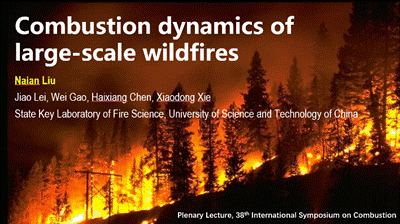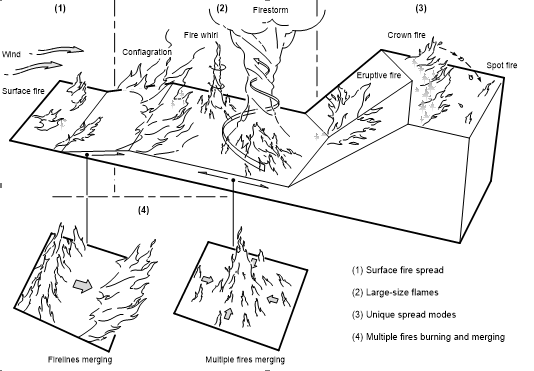| homepage News and Events News Releases |
| Prof. Liu Naian delivered aplenarylecture at the 38th International Symposium on Combustion |
| Date: 2021-02-03 Author: SKLFS Source: SKLFS |
The 38th International Symposium on Combustion was held from January 24th to 29th, 2021, in Adelaide, Australia. Due to therampant pandemic, the symposiumwas held online with the participation of more than 1,300 experts, scholars, and young students worldwide. Prof. Liu Naian atthe State Key Laboratory of Fire Science, the University of Science and Technology of China, was invited to deliver a one-hour plenary lecture at the symposium.
In recent years, the increasingly severe problems of large-scale wildfires worldwide have been receiving ever-growing academic attention. The high-intensity burning behaviors in wildfires stem from the significant interaction of combustion with heat transfer and atmospheric flow under complicated fuel, meteorology, and topography conditions. Therefore, mitigating measures against large-scale wildfire disasters have grown into a challenging research focus for combustion scientists. The lecture, entitled as “Combustion dynamics of large-scale wildfires”,depicts an overall pattern of the essential factors that lead an initial small-scale spreading flame to a large-scale wildfire beyond control. It is outlined that the complicated transformation of fuel preheating mechanisms determines the growth of surface fire spread, while varied large-size flame fronts and unique spread modes induced in specific fire environments play an essential role in fire spread acceleration. Additionally, multiple fires burning and merging often act as crucial steps for accelerating surface fire spread, generating large-size flames, and triggering unique spread modes. These major potential factors strike the energy balance of a low-intensity wildfire and push it to a high-intensity state. Several issues regarding intensely burning behaviors in large-scale wildfires are selected for in-depth discussions, for which an overview of the progress and challenges in research is presented. It is concluded that the fundamental exploration targeted at developing application tools capable of dealing with large-scale wildfires remains at its early stages. Opportunities for innovation are abundant, yet systematic and long-term research programs are required.
Figure 1. Schematic sketch of the potential factors leading a small-scale spreading flame to become a large-scale wildfire beyond control: (1) growth of surface fire spread, (2) large-size flames (conflagration, firestorm, and fire whirl), (3) unique spread modes (eruptive fire, crown fire, and spot fire), and (4) multiple fires burning and merging. Figure 1 depicts a schematic sketch of the potential factors leading a small-scale spreading flame to become a large-scale wildfire beyond control, extracted from the lecture paper published in Proceedings of the Combustion Institute(https://doi.org/10.1016/j.proci.2020.11.006). Signed: Prof. Naian Liu at the State Key Laboratory of Fire Science, University of Science and Technology of China
|
|
|
||
|
|
| Relevant link | ||
|
|
|
||||||||||
|
||||||||||

